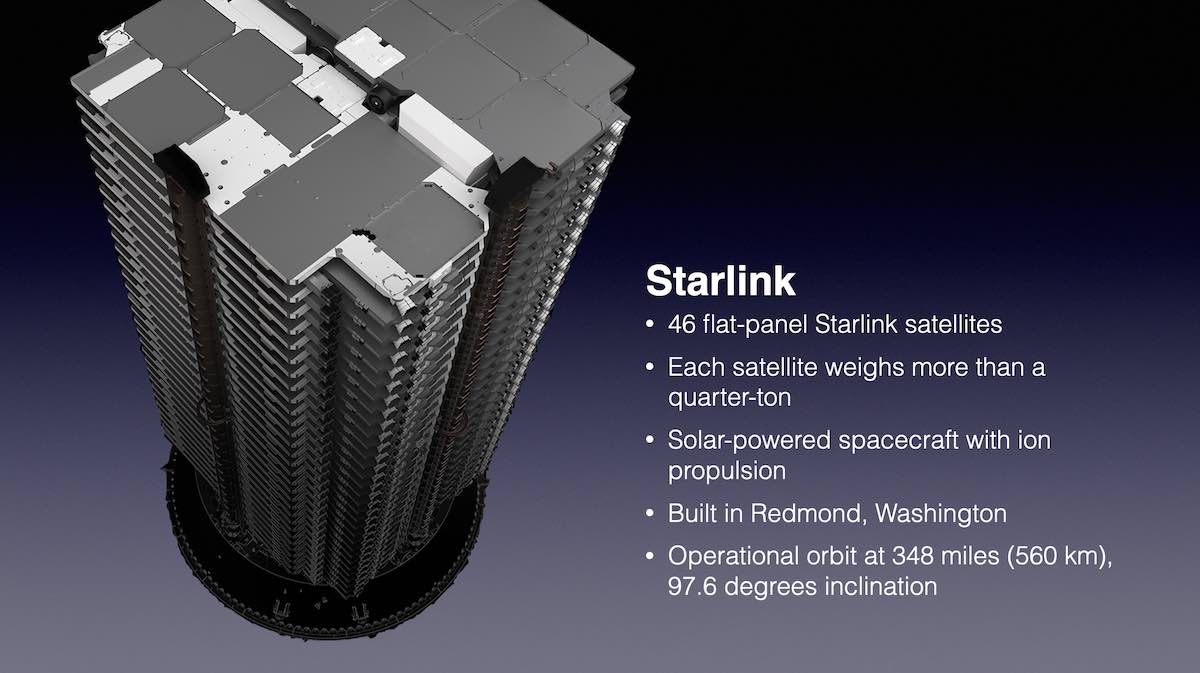
SpaceX launched a Falcon 9 rocket with 46 more Starlink internet satellites overnight Wednesday from Vandenberg Space Force Base in California, completing a quartet of rapid-fire polar orbit Starlink missions from the West Coast spaceport since mid-July.
The 229-foot-tall (70-meter) Falcon 9 rocket lifted off from Vandenberg Space Force Base at 10:40:10 p.m. PDT Tuesday (1:40:10 a.m. EDT Wednesday). The rocket lit nine Merlin 1D engines to power away from Space Launch Complex 4-East at Vandenberg, a military spaceport about 140 miles (225 kilometers) northwest of Los Angeles.
The kerosene-fueled engines generated 1.7 million pounds of thrust to propel the 1.2-million-pound launch vehicle off the pad. The Falcon 9 climbed through a star-filled sky and head south from the West Coast spaceport, arcing over the Pacific Ocean bound for polar orbit.
The Falcon 9 surpassed the speed of sound in about one minute, then the first stage booster shut down and separated from the Falcon 9’s upper stage about two-and-a-half minutes into the mission. The booster extended four titanium grid fins and reignited some of its engines to slow down for landing on a drone ship in the Pacific a few hundred miles downrange from Vandenberg.
The booster, designated B1063, touched down on the drone ship “Of Course I Still Love You” to complete its seventh flight to space. Around the same time, SpaceX confirmed the upper stage of the Falcon 9 shut off its engine after placing the Starlink satellites into a preliminary transfer orbit.
Liftoff of a Falcon 9 rocket from California on the Starlink 3-4 mission, adding 46 more internet relay stations to SpaceX’s global broadband network. https://t.co/OBh55Ssdsd pic.twitter.com/ucd2wdN5ak
— Spaceflight Now (@SpaceflightNow) August 31, 2022
A restart of the upper stage engine about 45 minutes later maneuvered the 46 satellites into the proper orbit for deployment. Four retention rods separated from the upper stage about 63 minutes into the mission, allowing the Starlink spacecraft to fly free of the rocket.
The Falcon 9 rocket’s guidance system targeted an orbital altitude between 190 miles and 199 miles (308-by-321 kilometers) at an inclination of 97.6 degrees to the equator.
The mission was numbered Starlink 3-4, and was the 58th dedicated SpaceX launch for the Starlink internet network. It was the ninth SpaceX launch from Vandenberg this year, and the company’s 39th launch of 2022 overall.
The 46 Starlink satellites will launch into one of five low Earth orbit “shells” in SpaceX’s internet constellation. SpaceX began launching dedicated missions into one of the network two polar orbit shells last month. SpaceX has previously launched satellites into the other three shells at inclinations of 53.0 degrees, 53.2 degrees, and 70 degrees to the equator.
After separating from the Falcon 9, the Starlink satellites are expected to disperse and extend solar panels to begin generating electricity to recharge their batteries. The satellites will go through an automated checkout and activation sequence, then use krypton-fueled ion thrusters to raise their altitude to 348 miles (560 kilometers), where they will enter operational service in the Starlink network.

The Starlink satellites each weigh more than a quarter-ton, and are built on SpaceX’s Starlink assembly line in Redmond, Washington. The spacecraft are fitted with laser inter-satellite links to facilitate data transfers in orbit, without needing to relay signals through ground stations, which come with geographical, and sometimes political, constraints. Laser crosslinks can also reduce latency in the Starlink network because signals need to travel a shorter distance.
SpaceX’s Starlink network provides low-latency broadband internet service to consumers around the world. The fleet is the largest constellation of satellites in orbit, with 2,383 Starlink spacecraft currently in service, and 489 more satellites raising their orbits or drifting into their operational positions in the network, according to a tabulation by Jonathan McDowell, an astrophysicist and expert tracker of spaceflight activity.
The 46 new satellites launched Wednesday brought the total number of Starlink spacecraft deployed to date to 3,208.
SpaceX’s Starlink 3-4 mission was the fourth straight launch from Vandenberg since July 10 to haul satellites into “Group 3” of the Starlink constellation. The 184 satellites launched on those four missions are enough to fill more than half of the slots in Group 3, which will eventually contain 348 satellites in polar orbit.

SpaceX is expected to take a pause from Group 3 launches for at least the next few months.
The next Falcon 9 launch from Vandenberg is scheduled for late September carrying a tranche of small demonstration satellites for the U.S. military’s Space Development Agency, which is developing a constellation of missile tracking and data relay spacecraft.
SpaceX’s next Falcon 9 launch from Cape Canaveral is scheduled for Sunday, Sept. 4, with a cluster of Starlink satellites heading for Group 4 in an orbit inclined 53.2 degrees to the equator.
Email the author.
Follow Stephen Clark on Twitter: @StephenClark1.
from Spaceflight Now https://ift.tt/DzomHS1
via World Space Info







0 comments:
Post a Comment